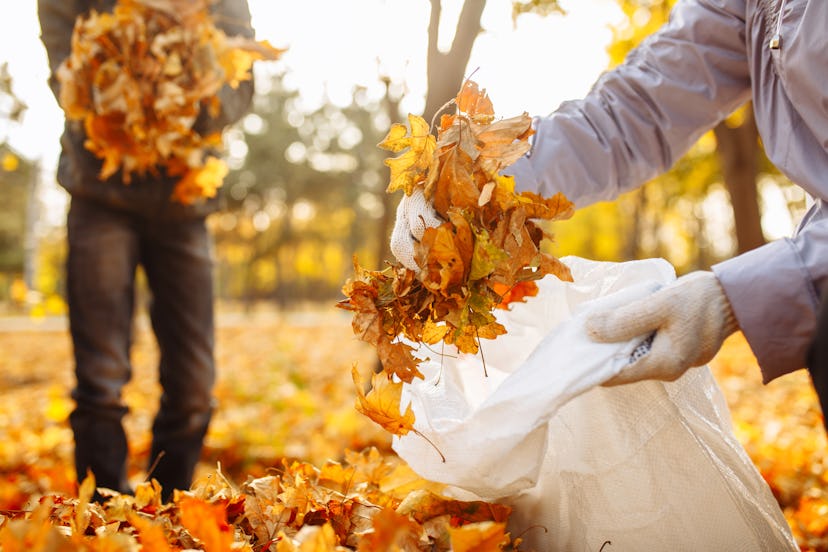Do You Need To Rake The Leaves In Your Yard? "No Rake Fall" Says Not Really
Put down the trash bag full of leaves, and open yourself up to a world of possibility.

If your fall to-do list has got your schedule bogged down, full of trick-or-treats, fall festivals, and home maintenance to prep for winter, we’ve got good news. There’s one time-consuming autumn chore you can scratch off the to-do list: bagging the fallen leaves in your yard.
That’s right, it’s officially “No Rake Fall,” — at least that’s what we’re calling it — and we’re here for it. But even though we made up a name for it, that doesn’t mean it’s not a totally real phenomenon. There’s a real, expert-driven reason to stop bagging your leaves and over-raking your lawn. Letting the leaves stay on the ground for a while benefits both your grass and the planet. Here’s what you need to know.
How does “No Rake Fall” help my lawn?
Experts agree that lawns actually benefit when you leave a layer of autumnal leaves to decompose on your grass. In other words, just because the first leaves have fallen doesn’t mean you need to go grab a rake, gather all those leaves, and shove them into a jumbo trash bag.
Leaves are full of nutrients that help grass grow stronger, and leaving them on the ground (no pun intended) provides a home for all the beneficial insects that help your garden thrive come springtime.
Additionally, research has shown that as much as eight million tons of leaves and yard debris end up in landfills each fall, taking up valuable space and costing taxpayers. When large piles of leaves are left to decompose in landfills without adequate oxygen (AKA inside of bags), studies show that they release increased levels of methane, one of the most potent greenhouse gasses. When they decompose outside of bags, the same doesn’t happen.
As leaves decompose, vital compounds are released into the soil and absorbed by roots. Nutrients like nitrogen, phosphorus, and potassium help plants grow strong roots to withstand winter temperature changes and come back better than ever in the spring.
A layer of leaf litter also helps retain moisture below the ground’s surface and helps grass to maintain healthy temperatures, so that plants aren’t as shocked by sudden temperature drops as the weather gets colder. Additionally, the decomposing leaves improve the overall quality of the soil.
“Those nutrients are being returned to the soil," Susan Barton, a professor and extension specialist in landscape horticulture at the University of Delaware, explained to NPR. "But probably even more important than that, it's the organic matter. It's the fact that you've got this tissue that then eventually decomposes and improves the soil health."
How do I participate in “No Rake Fall?”
One, it’s important to note that No Rake Fall doesn’t mean you’ll never, ever have to take care of your front lawn again.
No Rake Fall doesn’t mean you can just leave a huge mat of leaves on your lawn. Too thick of a layer of mulch will kill grass and plants. But you can intervene with your lawn far less than you would normally if you do intend to participate. Experts recommend simply running your mower over the leaves to chop them into smaller pieces that decompose more quickly and won't harm your lawn or garden.
"Ideally, you want to let them decompose a little bit, and they'll form a very nice mulch. Instead of going out and buying hardwood bark mulch, which is expensive, you can have a better mulch that's free," Barton explained.
Spread thin, leaves virtually disappear into the lawn after a day or two, so they won't be an eyesore for those who cherish a well-manicured space.
If you have too many leaves, you can always add extras to your flower beds and vegetable gardens. Leaf litter is a great way to attract earthworms, which are incredibly beneficial for gardens come spring.
And don’t worry if your kids look forward to a giant leaf pile every year. You can always rake or blow leaves for the kids to frolic in, then blow them back out before you run your mower or mulcher. That way, everyone is happy — the kids, the grass, the bugs, and the Earth!